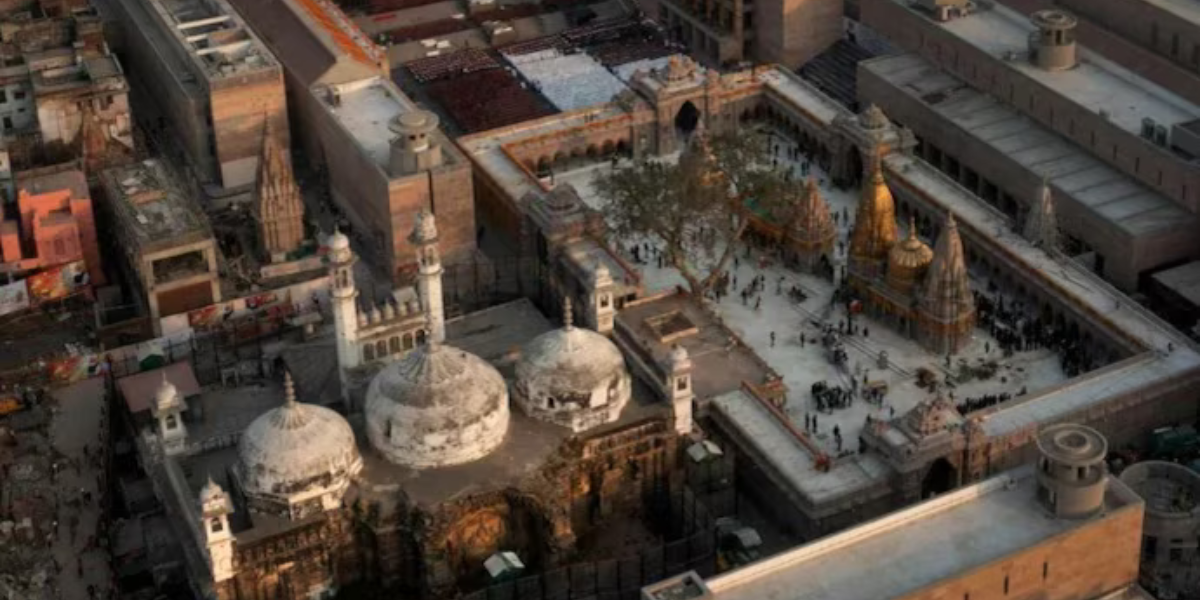The Archaeological Survey of India (ASI) has recently released a groundbreaking report on the sculptures Gyanvapi complex, challenging conventional beliefs about its religious affiliations. Previously perceived as a site exclusively dedicated to Lord Shiva, the comprehensive excavation carried out by the ASI has unveiled an intricate tapestry of deities, prominently featuring Lord Vishnu and Lord Hanuman. This in-depth exploration aims to delve into the rich heritage revealed by the ASI’s survey, shedding light on the diverse cultural and religious practices that flourished within the Gyanvapi complex.

Table of Contents
Hanuman’s Iconic Posture: Unveiling the Symbolism at Gyanvapi
The ASI’s excavations have brought to light the lower half of a sculptures depicting Hanuman, showcasing his iconic posture with one leg placed on a rock. This discovery not only emphasizes the meticulous craftsmanship of the artisans but also invites us to explore the symbolism embedded in Hanuman’s posture. Hanuman, a revered deity in Hinduism, is often depicted in dynamic poses symbolizing strength, devotion, and unwavering dedication to Lord Rama. The ASI’s findings prompt a deeper analysis of the significance of Hanuman’s posture within the context of worship and religious iconography.
Early Medieval Sculptures: Attendant of Lord Vishnu’s Varaha Avatar
Among the remarkable finds is an Early Medieval sculpture fragment featuring a half-human, half-snake figure, possibly representing an attendant of Lord Vishnu’s Varaha avatar. Varaha, the boar incarnation of Vishnu, is a central figure in Hindu mythology, associated with the cosmic order and the protection of dharma. The ASI’s discovery raises intriguing questions about the role of this enigmatic figure and its connection to the worship of Lord Vishnu. Exploring the symbolism and religious narratives surrounding Varaha and his attendants adds depth to our understanding of the cultural milieu at Gyanvapi.

Four-Handed Vishnu Seated in Traditional Posture: Regality Amidst Ruins
The excavation has uncovered a broken back-slab portraying a four-handed Vishnu seated in a traditional posture, holding a chakra and shankha. Despite the damages, the regal adornment of the deity remains discernible. This finding not only showcases the artistic finesse of the sculptors but also invites speculation about the historical context in which this particular representation of Vishnu existed. Analyzing the symbolism of Vishnu’s attributes and examining the regal adornment adds layers to the narrative of religious expression and artistic traditions within the Gyanvapi complex.
Late Medieval Hanuman Sculptures: Evolution of Depictions
The Late Medieval period yields a sculpture capturing the lower part of Hanuman’s image, featuring firmly set feet on a rock. This portrayal suggests an evolution in the depiction of Hanuman over time. Understanding the changes in artistic representations of Hanuman provides insights into the evolving religious sentiments and cultural dynamics within the Gyanvapi complex. This section delves into the nuances of the Late Medieval Hanuman sculpture, exploring its stylistic elements, narrative significance, and potential influences from contemporary cultural and religious trends.
Early Medieval Sculptures of Lord Vishnu: Unveiling Devotion
The ASI’s excavation has brought to light two sculptures of Lord Vishnu from the Early Medieval period. One depicts the deity standing on a pedestal with three of his four hands, while the other illustrates a devotee and an attendant by Vishnu’s side. These sculptures provide a window into the devotion and reverence accorded to Lord Vishnu by the followers within the Gyanvapi complex. Analyzing the artistic details, the damaged face of Vishnu, and the accompanying figures deepens our understanding of the multifaceted religious landscape at Gyanvapi.
Late Medieval Hanuman Sculpture with ‘Gada’: Revered Despite Fragmentation

Another noteworthy discovery is a Late Medieval sculpture portraying the upper half of Hanuman, with one hand gripping a ‘gada’ or mace. Despite the figure being broken at the waist, the intact high crown signifies the revered status of the deity. This section explores the symbolic significance of Hanuman’s attributes, such as the ‘gada,’ and delves into the broader cultural and religious implications of this Late Medieval representation. Understanding the reverence accorded to Hanuman, even in fragmented form, adds a poignant layer to the narrative of religious continuity and devotion at Gyanvapi.

In conclusion, the ASI’s exhaustive survey of the Gyanvapi complex has unearthed a treasure trove of cultural and religious heritage, challenging preconceived notions about the site’s singular dedication to Lord Shiva. The presence and veneration of Lord Vishnu and Lord Hanuman within the archaeological findings paint a vivid picture of a complex and dynamic religious landscape. Each sculpture, fragment, and artifact tells a story of artistic brilliance, evolving religious sentiments, and the interplay of diverse cultural influences. This exploration not only enriches our understanding of the Gyanvapi complex but also beckons scholars, historians, and enthusiasts to further unravel the layers of history embedded in this sacred space.

